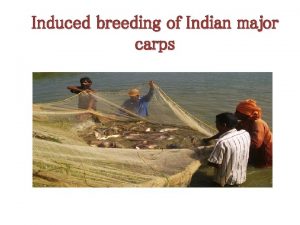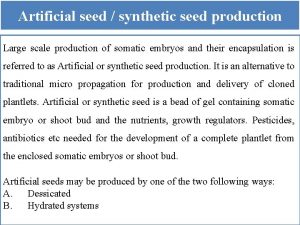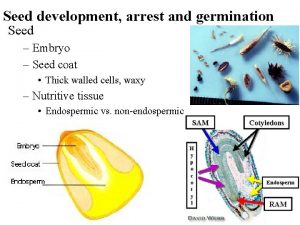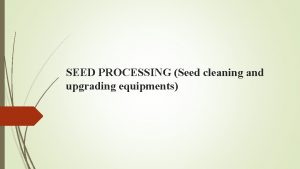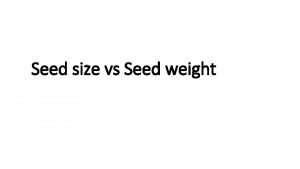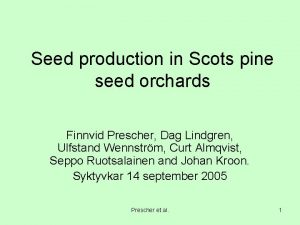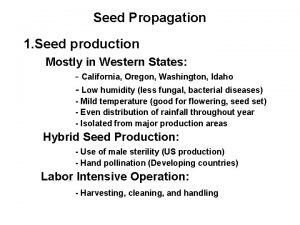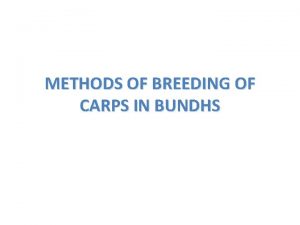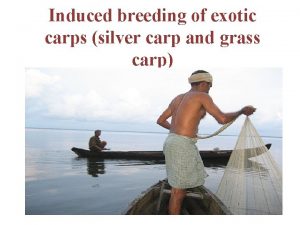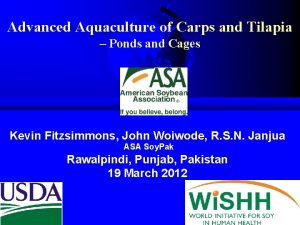Seed production of indigenous carps INTRODUCTION The prioritized

















- Slides: 17

Seed production of indigenous carps

INTRODUCTION • The prioritized species for rehabilitation are the Cauvery/Carnatic carp, Puntius carnaticus, indigenous grass carp, P. pulchellus and olive barb, P. sarana. Broodstock development and breeding of olive barb, P. sarana Collection of wild fish • Live specimens of P. sarana could be collected from reservoir, river, etc. using gill net/cast net. • Fishes are immediately anaesthetized with quinaldine (20 ppm) for 2 minutes and transferred to high density poly ethylene bags (capacity 10 kg) containing clear water taken from the vicinity. P. sarana

Packing and transportation • The fishes are packed in plastic bags with 1/3 water and 2/3 pure oxygen and transported using plastic crate/carton box, by car. • During transit, partial water exchange may be done and O 2 filled to the bag. • Regular checking of bags for any leakage should be carried out during transportation.

Acclimatization • Holding tanks - disinfected with a solution of KMn. O 4 (5 ppm) and water was filled to 3/4 of its volume and allowed to stabilize for 2 -3 days • Netting should be used as a cover to avoid the escape of fish or predation by birds. • In case of wounds, fishes are given a bath treatment with KMn. O 4 (5 ppm) for 2 minutes. • After every 24 hours, swabbing may be done. • The fishes are fed with pelleted feed during acclimatization when they do not normally accept it

Raising captive brood-stock • Rectangular concrete ponds having an area of 50 m 2 with soil base (6 -8’’) are suitable for raising broodstock. • Each pond is provided with netting to avoid predation by birds. • The fingerlings are were fed with crumbles of a formulated pelleted feed (about 30% protein) at 3% of their body weight once daily. • The proportion of feed ingredients is : 30% fish meal, 24% ground nut oil cake, 25% rice bran, 10% wheat flour, 10% tapioca flour and 1% vitamin and mineral mixture).

Identification of sex of brooders • At periodic intervals, the fish is individually checked for their maturity stage. • identification of sexes - observing the external morphological characters like genital aperture, shape of abdomen colouration of fins, size of fish etc • Males were found to be smaller than females. Male (top) and female (bottom) brooders

The keys used for the identification of sex of brooders are as follows: Female Male Larger in size, slightly smaller pectoral Smaller in size, slightly larger pectoral fin, a few ova discharged on applying milt oozes out on applying pressure on abdomen Pectoral fin brighter, body stouter Pectoral fin duller, body linear

Induced breeding • P. sarana could be induced bred during southwest monsoon with intramuscular injection of ovatide at 0. 05 -0. 1 ml per female and 0. 03 -0. 05 ml per male • The injected brooders (1: 2) are held in breeding hapa for spawning. • About one kg of Hydrilla, and a few bundles of marginal grass are used as a substratum (egg collector). • The interval between injection of hormone and spawning is about 8 -10 hours at 26 - 27. 50 C. Small. sticky fertilized eggs

• The eggs are small (0. 9 mm diameter) and transparent • Fertilization and hatching rates obtained are as high as 92. 5 and 65%, respectively • The hatching and yolk-sac absorption periods are 15 -20 hours and 3 -4 days, respectively, at 25 -300 C • The length of one- day- old hatchling is 3. 9 mm and that of the first to fifth-day-old is 3. 87, 4. 71, 6. 20, 6. 85 and 7. 26, respectively Three-day-old spawn

12 -day-old fry Fingerlings Advanced fingerlings

Nursery rearing • Concrete pond (50 m 2) with a soil base is used • The bottom of the pond is allowed to dry till the bottom mud cracked • Subsequently the pond is limed using agricultural lime at 0. 5 -1. 0 kg and water is filled into the pond up to 0. 5 m and then fertilized with poultry manure at 1. 0 -1. 5 kg

• The pond water level is gradually raised to 1 m • About 30% of water is exchanged whenever plankton bloom occurs • Poultry manure is added in split doses to maintain the productivity of pond • Commercially available fish feed (Growbest) powder could be successfully used for feeding the hatchlings/fry in the nursery

Collection, development of broodstock and breeding of the Carnatic/Cauvery carp, P. carnaticus • About 50 fishes of P. carnaticus ranging in weight between 20 and 560 g were collected from the river Cauvery, transported live to Mangalore and are being reared to maturity • The age of the fishes is 0 to 3+ years • Males attain maturity earlier than females in captivity P. carnaticus Female (top) and male (bottom)brooders

Male oozing milt Vehicle showing facility for live transport of fish

Collection, development of broodstock and breeding of indigenous grass carp, P. pulchellus • Gill net fish sampling undertaken at Hariharapura on the river Tunga (a tributary of the Tungabhadra) yielded nearly 150 early fingerlings and 8 advanced fingerlings (100 -120 g) of P. pulchellus. • The broodstock is being developed at the College. P. pulchellus Sampling for P. pulchellus

Immature P. pulchellus and mahseers in a temple pool at Sringeri P. pulchellus broodstock

 Hypophysation definition
Hypophysation definition My bobs workday
My bobs workday Carps report kenya
Carps report kenya Production pre production post production
Production pre production post production Introduction to indigenous creative crafts
Introduction to indigenous creative crafts Isolation distance
Isolation distance Indigenous axiology
Indigenous axiology Native american medicine wheel colors
Native american medicine wheel colors Herman michell
Herman michell What is indigenous research
What is indigenous research Indigenous methodologies
Indigenous methodologies Indigenous knowledge systems tok
Indigenous knowledge systems tok Indigenous name for forced labour
Indigenous name for forced labour Indo-ayran
Indo-ayran World council of indigenous peoples
World council of indigenous peoples Cocciq
Cocciq Simple machines used by first nations
Simple machines used by first nations Taliban vs western values ap human geography
Taliban vs western values ap human geography
